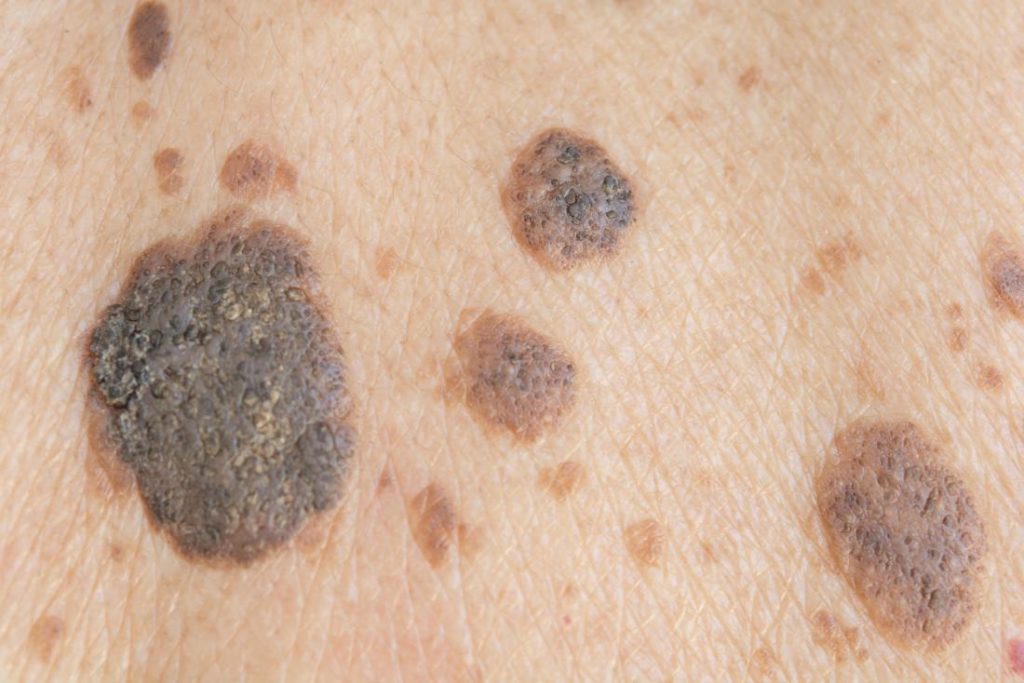SEBORRHEIC KERATOSIS

Definition: Seborrheic keratosis is one of the most common types of noncancerous (benign) skin growths in older adults. In fact, most people develop at least one seborrheic keratosis at some point in their lives. [1]
Other names: Barnacles [2]
Symptoms
A seborrheic keratosis usually appears as a brown, black or pale growth on the face, chest, shoulders or back. However, a seborrheic keratosis can occur almost anywhere on the body. The growth has a waxy, scaly, slightly elevated appearance that distinguishes it from a mole. Occasionally, it appears singly, but multiple growths are more common. A seborrheic keratosis is also usually round or oval shaped and range in size from very small to more than 1 inch (2.5 centimeters) across. [2]
A seborrheic keratosis has a characteristic “pasted on” look. They are classically described as looking like someone took clay or a blob of dirt and “stuck” it on the skin. The edge of the seborrheic keratosis is not attached to the underlying skin making it appear that it could be removed by picking it off with your fingernail. This is because seborrheic keratoses arise from the epidermis, or top layer of skin. They don’t extend deep into the skin like warts. [2]
There are two different appearances of a seborrheic keratosis; a flat (smooth surface) or slightly elevated with a warty surface.
Warty surface – Seborrheic keratoses may look like warts but they don’t contain human papilloma viruses that cause warts. As they develop some can have a very rough surface with deep pits and fissures almost like cauliflower being pulled apart. [2]
Smooth surface with horn pearls – Some seborrheic keratoses don’t have a rough surface. If they are smooth, they contain tiny bumps that look like seeds that are lighter or darker than the surrounding tissue. These are called horn pearls and they are actually bits of keratin that develop in a whirling, circular pattern. Sometimes these horn pearls are best seen with a magnifying glass. [2]
Seborrheic keratoses tend to itch especially in older people. Some people will unintentionally manipulate or “pick at” a seborrheic keratosis and cause it to be further irritated and itch more. If irritated enough, the skin around it can become red and the seborrheic keratosis itself can bleed. [1]
Seborrheic keratoses are move common in people over age 50 and those who have this condition in their families, suggesting a genetic component. [1]
Treatment
The first and usually the best choice is to leave them alone. They may get larger, but they are not precancerous so leaving them there for the life of your skin is not a problem. Seborrheic keratoses are usually removed because they itch, they interfere with clothing or jewelry, or they are cosmetically unacceptable.
Removing Seborrheic Keratosis
If you decide to have a seborrheic keratosis removed, there are several ways to do this. A few of the most common are listed here.
- Liquid Nitrogen – A small seborrheic keratosis can be frozen with liquid nitrogen. Liquid nitrogen works by freezing and destroying the cells but leaving the connective tissue foundation intact. The lesion frozen forms a blister as the water is released from the dead cells then crusts over as the water dries. When the crust falls off after several days, the skin underneath has begun to repair itself and will heal quickly if left alone. Liquid nitrogen can leave a scar as the repaired skin may have more or less pigment producing cells. The scar is usually flat though unless you have a tendency to form keloids. [2]
- Shave – Another way seborrheic keratoses can be removed is to shave them off. Because their attachment to the underlying skin covers less area than the lesion itself, shaving can be a viable option. [2] Seborrheic Keratoses are shaved off easily in the clinic with a flexible razor blade going just deep enough to get only the seborrheic keratosis cells and leave normal skin. Shaving too much normal skin off can leave a divot or hole in the skin that may scar. After the lesion is shaved, a chemical agent such as aluminum chloride or silver nitrate is applied to the wound to stop any small surface bleeding and cauterize the wound. Silver nitrate is a dark brown color and the resulting wound after the shave is dark brown. This color will usually go away after the skin repairs but some of that pigment can remain. [2]
- Burning with an electric current (electrocautery) – Used alone or with curettage, electrocautery can be effective in removing seborrheic keratoses. This procedure can leave scars if it’s not done properly, and it may take longer than other removal methods. [1]
Keep in mind that most insurance companies and Medicare won’t pay for the removal of seborrheic keratoses if done only for cosmetic reasons. Medical reasons for seborrheic keratosis treatment include intense itching, pain, inflammation, bleeding and infection. [1]
When to see a Doctor
Sometimes seborrheic keratoses can be very difficult to distinguish from melanoma. Especially when they first appear, they can have several of the characteristics of atypical growths including irregular borders and color variation throughout the lesion. You should not hesitate to see your doctor about any skin rashes or bumps that concern you. [2]
References
1. Seborrheic keratosis. http://dermatology.about.com/cs/benignlesions/a/sebk.htm


